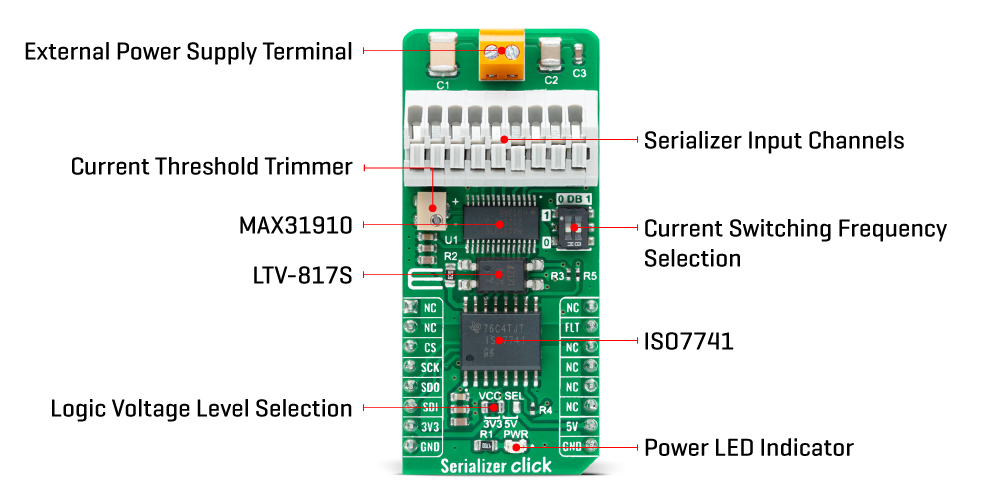20%
OFF
GO LOCAL
| Company | Stock | Price |
|---|---|---|

MIKROE-4925
24 g
Status:
Serializer Click is a compact add-on board that contains a digital input translator/serializer. This board features the MAX31910, an eight-channel digital input serializer for high-channel density digital input modules in industrial and process automation from Analog Devices. The MAX31910 translates, conditions, and serializes the 24V digital output of sensors and switches to 5V CMOS-compatible signals required by the MCU. It provides the front-end interface circuit of a programmable logic controller (PLC) digital input module. It communicates with MCU via the SPI interface and comes in configuration with an installed digital isolator. This Click board™ is suited for various applications such as industrial, process, and building automation, digital input modules for PLCs, and more.
Serializer Click is supported by a mikroSDK compliant library, which includes functions that simplify software development. This Click board™ comes as a fully tested product, ready to be used on a system equipped with the mikroBUS™ socket.
This product is no longer in stock
Availability date:
20%
OFF
| Company | Stock | Price |
|---|---|---|

Serializer Click as its foundation uses the MAX31910, an eight-channel digital input translator/serializer for high-channel density digital input modules in industrial and process automation from Maxim Integrated, now part of Analog Devices. It features integrated current limiting, low-pass filtering, and channel serialization. Input current limiting allows a significant reduction in power consumed from the field voltage supply (external typical 24V) compared to traditional discrete resistor-divider implementations. The device uses patent-pending circuit techniques to further reduce power beyond possible input current limiting alone.

The MAX31910 translates, conditions, and serializes the 24V digital output of sensors and switches to 5V CMOS-compatible signals required by the MCU. It provides the front-end interface circuit of a programmable logic controller (PLC) digital input module. Selectable on-chip low-pass filters allow flexible debouncing and filtering sensor outputs based on the application. The serializer is stackable so that any number of input channels (IN1-IN8) can be serialized and output through only one SPI-compatible port.
The serializer inputs (IN1-IN8) sense the state (ON vs. OFF) of field sensors by monitoring both voltage and a current flowing through the sensor output. The current sinking through these input pins rises linearly with input voltage until the limit set by the current clamp is reached (set by an onboard potentiometer). Any voltage increase beyond this point does not further increase the input current.
Serializer Click communicates with MCU through a standard SPI interface in a configuration with installed digital isolators (ISO7741 and LTV-817S). Also, it uses an interrupt pin, the FLT pin of the mikroBUS™ socket, used as a ‘fault’ indicator which immediately notifies the host when a fault such as an overtemperature or undervoltage condition occurs. It also has a two-channel switch labeled DB, which determines the current switching frequency. The current switching clock period is automatically selected according to a switch position.
This Click board™ can operate with both 3.3V and 5V logic voltage levels selected via the VCC SEL jumper. This way, it is allowed for both 3.3V and 5V capable MCUs to use the communication lines properly. However, the Click board™ comes equipped with a library containing easy-to-use functions and an example code that can be used, as a reference, for further development.
Type
Measurements
Applications
Can be used for various applications such as industrial, process, and building automation, digital input modules for PLCs, and more
On-board modules
MAX31910 - eight-channel digital input translator/serializer from Maxim Integrated, now part of Analog Devices
Key Features
Low power consumption, highly integrated, eight channels, robust features and performance for industrial environments, flexible power supply capability, and more
Interface
SPI
Feature
No ClickID
Compatibility
mikroBUS™
Click board size
L (57.15 x 25.4 mm)
Input Voltage
3.3V or 5V,External
This table shows how the pinout on Serializer Click corresponds to the pinout on the mikroBUS™ socket (the latter shown in the two middle columns).
| Label | Name | Default | Description |
|---|---|---|---|
| LD1 | PWR | - | Power LED Indicator |
| JP1 | VCC SEL | Left | Logic Level Voltage Selection 3V3/5V: Left position 3V3, Right position 5V |
| SW1 | DB | - | Current Switching Frequency Selection 1/0: Upper position 1, Lower position 0 |
| P1 | - | - | Current Threshold Trimmer |
| Description | Min | Typ | Max | Unit |
|---|---|---|---|---|
| Supply Voltage VCC | 3.3 | - | 5 | V |
| External Supply Voltage | 7 | 24 | 36 | V |
| Input Data Rate | - | 200 | - | kHz |
| Operating Temperature Range | -40 | +25 | 125 | °C |
We provide a library for the Serializer Click as well as a demo application (example), developed using MikroElektronika compilers. The demo can run on all the main MikroElektronika development boards.
Package can be downloaded/installed directly from NECTO Studio Package Manager(recommended way), downloaded from our LibStock™ or found on Mikroe github account.
Library Description
This library contains API for Serializer Click driver.
Key functions
serializer_get_flt_pin This function returns the fault pin logic state.
serializer_read_input This function reads the input data by using SPI serial interface, and then checks the data integrity by verifying the CRC byte.
Example Description
This example demonstrates the use of a Serializer Click board™ by reading the state of all inputs and displaying the results on the USB UART.
void application_task ( void )
{
uint8_t input_data = 0;
err_t status = serializer_read_input ( &serializer, &input_data );
if ( SERIALIZER_ERROR != status )
{
for ( uint8_t cnt = 0; cnt < 8; cnt++ )
{
log_printf( &logger, " IN%u: %srn", ( uint16_t ) cnt + 1,
( char * ) ( ( input_data & ( 1 << cnt ) ) ? "High" : "Low" ) );
}
if ( status & SERIALIZER_STATUS_UNDERVOLTAGE )
{
log_info( &logger, "Undervoltage fault" );
}
if ( status & SERIALIZER_STATUS_OVERTEMPERATURE )
{
log_info( &logger, "Overtemperature fault" );
}
log_printf( &logger, "rn" );
Delay_ms( 1000 );
}
}
The full application code, and ready to use projects can be installed directly from NECTO Studio Package Manager(recommended way), downloaded from our LibStock™ or found on Mikroe github account.
Other Mikroe Libraries used in the example:
Additional notes and informations
Depending on the development board you are using, you may need USB UART click, USB UART 2 Click or RS232 Click to connect to your PC, for development systems with no UART to USB interface available on the board. UART terminal is available in all MikroElektronika compilers.
This Click board™ is supported with mikroSDK - MikroElektronika Software Development Kit. To ensure proper operation of mikroSDK compliant Click board™ demo applications, mikroSDK should be downloaded from the LibStock and installed for the compiler you are using.
For more information about mikroSDK, visit the official page.
NOTE: Please be advised that any peripheral devices or accessories shown connected to the Click board™ are not included in the package. Check their availability in our shop or in the YMAN section below.